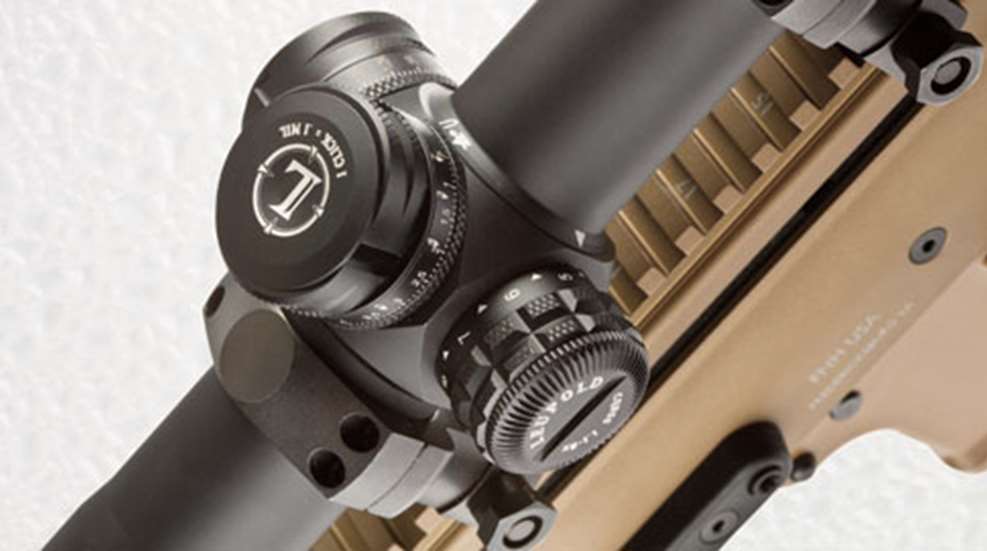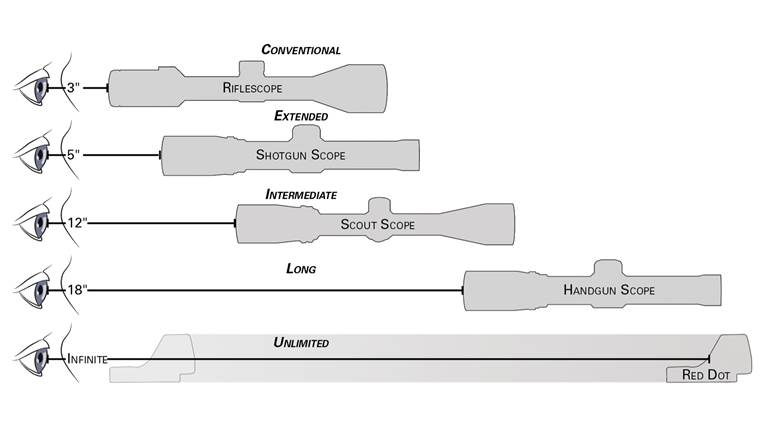
A group of U.S. military operators recently asked Leupold to develop a specialized scope to aid them in their responsibility of providing overwatch support as snipers. Snipers often have to take the high ground, which frequently requires them to kick in the door of a building and clear it room-to-room, so they can set up on the roof. In short, if they are going to perform their long-range mission, they must first complete a close-quarters mission. Naturally, their arms and equipment have to be suitable for both situations. Mounting a red-dot scope and a sniper scope on their rifles was a stop-gap solution. Small red-dot scopes or holo sights were prone to breakage; larger, more robust red-dot sights proved to be cumbersome. These operators approached Leupold and asked it to develop a scope that could perform both the CQB (Close Quarters Battle) and SS (Scout-Sniper) mission. In response to this request, Leupold’s Tactical Optics Division has introduced the first optic in its new line of Mark 8 riflescopes, the 1.1-8X 24 mm CQBSS.
The new CQBSS (Close Quarters Battle Scout Sniper) is a front-focal plane 1.1-8X power optic built on a 34 mm main tube utilizing a Horus 27 illuminated dot reticle or a Leupold M-TMR (Marine Tactical Milling Reticle). The rugged CQBSS has a number of well-thought-out ergonomic features. The windage and elevation adjustment dials are about 1 1/4 inches in diameter, but they are not protected with any type of removable cap. Instead, they use an auto-locking “Pinch-and-Turn” adjustment system. The top halves of the windage and elevation turrets have two knurled, semi-circular squeeze pads with a central, V-shaped groove. Squeezing the two rings together between the thumb and forefinger releases the auto-locking mechanism and allows the turret to rotate. Once the appropriate adjustments are made, releasing the squeeze pads locks the turret in place. The secure system is designed to be easy to use under stress. The dials also have built-in zero stops. Windage and elevation reticle adjustments are 0.10 mil-per-click with 10 mils of adjustment per turn.
The BDC reticle is built around a 100-yard zero. Hash marks indicating each 0.10 mil-click run around the base of the windage and elevation turrets. Each 0.50 mil is numerically indexed on the adjustment ring as well. In addition, range call-offs in hundreds of meters for a specific load are superscripted just above those for the mils.
A fully checkered sleeve for the ocular bell controls the scope’s magnification setting. Turning the ocular sleeve clockwise boosts magnification and turning it counter-clockwise reduces magnification.
A thumb pad at the front of the bell provides a visual and tactile indication of the magnification setting. The pad rests at 12 o’clock at 1.1X, and at six o’clock at 8X. In addition to its nearly 8X zoom capability, the 34 mm aluminum main tube provides an overall adjustment range of 100 mils for both windage and elevation. The large, illumination adjustment knob is mounted on the left side of the bridge directly opposite to the windage turret, and it is knurled and grooved for easy grasping. There are “off” position detents between each of the eight numerically indexed brightness settings, so the reticle is never more than one click away from being off or on the appropriate brightness setting. The brightness knob is a large, knurled and grooved turret so you do not have to fumble around for it. The brightness knob also serves as a housing for the CR2032 battery that powers the illuminated reticle.
The reticle is in the front focal plane, which means that as magnification is increased the size of the reticle will increase proportionately. At first, this appears to be a surprising choice; second plane reticles are almost universal among riflescopes made for the American sporting market. One might think that the more precise aiming point that a second-plane scope delivers at higher magnification might provide a useful advantage to a precision marksman; however, the constant subtension of a first-focal-plane scope and the ranging ability it provides at any power setting is far more important to a trained precision marksman taught to calculate range in mils by observing targets.
The Horus Vision H27 reticle is offered in Mark 8 scopes produced for the military and law enforcement. Leupold’s new Marine-Tactical Milling Reticle (M-TMR) is offered in the Mark 8 for civilian shooting enthusiasts.
The mil-based Horus Vision H27 reticle employs a two-dimensional grid system that helps enhance both accuracy and ease of use. It has two thick, horizontal stadia arms and a fine, 0.5-mil vertical stadia arm in the lower field of view. The fine grid marks in the lower half of the field of view do not obscure long-range targets that require a lot of holdover. A five-m.o.a. illuminated dot expands to a donut-style ring at higher magnification setting. Leupold’s M-TMR is designed to simplify successful range estimation and target engagement. Its stepped configuration might be called a triplex reticle. The centermost arms subtend 0.10 mil. Both the horizontal and vertical arms are indexed with perpendicular hash marks every 0.10 mil. The second set of stadia arms subtend 1 mil and are indexed every 0.50 mil. The outermost arms subtend 2.0 mils and are indexed every 0.50 mil as well. When the illumination knob is turned to one of the eight “on” positions, only the second set arms are illuminated.
Given the military use for which the CQBSS was originally developed, ruggedness and durability were critical elements of the design. The CQBSS is filled with an argon/krypton gas blend that helps make the scope fog-proof and waterproof, having been tested to 66 feet of submersion. The Mark 8 has a matte-black finish and features Leupold’s Index Matched Lens System with DiamondCoat 2, which helps provide increased light transmission and scratch resistance that exceeds military specifications.
The BDC ring on my sample scope was set up for the 5.56x45 mm NATO MK 262 Mod I load, so I mounted the scope on a FNH-USA SCAR 16S using tall steel Leupold rings compatible with the gun’s Picatinny top rail. I took it to our test range in order to familiarize myself with the scope’s unique illumination and magnification controls and get a feel for how the M-TMR reticle worked indoors.
The thick 2-mil-wide vertical and horizontal arms of the reticle glow red when illuminated, but the thinnest 1/2-mil thick arms at the center of the reticle do not glow at all. The large brightness-adjustment turret produced positive, discernible clicks at every level of adjustment. I then took the CQBSS to an outdoor range to see what I could get out of this optic. Since there is no need for a multi-tool or coin to make the adjustments, the pinch-style, auto-locking windage and elevation dials greatly simplified the zeroing process. The adjustment dials are very easy to turn, but when they are released they lock solidly in place, so there is no need to worry about them moving when they brush against gear or obstacles.
After obtaining a solid zero I “shot the square.” From zero, I turned 10 clicks up and 10 clicks right then fired a five-shot group. I then turned the elevation dial 20 clicks down and fired a second group. After turning the windage turret 20 clicks left, I fired a third group. I then turned 20 clicks up before firing a fourth group and lastly I turned 10 clicks right and 10 clicks down to return to zero. The scope formed a perfect 6½ by 6½-inch square with the last group neatly superimposed on the first. Thus, the adjustments were clearly positive and repeatable, but more than that, the clearly marked zero stops meant there was no “getting lost” in the dial.
Luckily I had 400 meters available to me so I was able to get some idea of the scope’s potential at extended ranges. As I transitioned between 100-meter and 400-meter targets, the BDC dial proved to be a valuable asset. By putting the proper clicks on the dial, rather than fudging with “Kentucky windage,” I felt like I was able to get better hits faster.
I then set up a series of D- and E-type silhouettes at a variety of short-range distances varying from 7 yards to 50 yards. Shooting a rapid-fire series I was pleased by how quickly I was able to transition from target to target. With the scope set on 1.1X, it was easy to keep both eyes open for less fatigue and better situational awareness. In addition, I was surprised to discover that the large turrets disappeared from my field-of-view when my shooting eye was in the scope.
In sum, the Mark 8 1.1-8X 24 mm is big. It’s also heavy and expensive. It’s not by any means perfect, but it certainly does a lot of amazing things. An ideal CQB scope would be smaller. An ideal sniper scope would have a larger objective. It’s incredibly rugged and easy to use. Because it is so versatile with its wide range of magnification, rapid and repeatable windage and elevation adjustments, the CQBSS has a lot to offer law enforcement and military precision-marksmen. Any marksman trained to range in mils will find the M-TMR reticle to be an incredible tool. I suspect many three-gun competitors may decide that two scopes are a cheaper alternative; and that ruggedness is desirable, but it’s not a life-or-death consideration. Given the cost, LE and military users are the most likely buyers, but to paraphrase Ferris Bueller’s evaluation of the Ferrari 250 GT, if you have the means, it’s an excellent choice.
Reticle: Horus H27 with illuminated dot; M-TMR with illuminated cross-hairs (tested)
Lens Coating: index matched lens system with diamond coat
Adjustment Markings: pinch & turn auto-locking 0.10 mil
Main Tube Diameter: 34 mm
Eyepiece Design: lockable fast-focus
Magnification: 1.1-8X
Linear Field of View: 31-4.9 meters at 100 meters
Exit Pupil: 8.0-3.0 mm
Weight: 23.2 ozs.
Length: 11¾"
Mounting Area: 6½"
Objective Aperture: 24 mm
Eye Relief: 3.7"-3.3"
Elevation Adjustment Range: 100 m.o.a.
Windage Adjustment Range: 100 m.o.a.; BDC rings are available for MK 262 Mod 1 77-gr. 5.56x45 mm NATO and M118 LR 175-gr. 7.62x51 mm NATO
Accessories: flip-open lens covers and a 2½" sun shade are standard.
Suggested Retail Price: $4,000






































